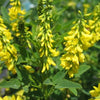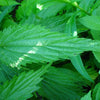Nettle: Benefits in Benign Prostatic Hyperplasia

Urtica Dioica , commonly known as nettle , is known for its diuretic, antirheumatic, anti-inflammatory properties and for its use in the treatment of benign prostatic hyperplasia (BPH) .
INDEX
1. DESCRIPTION
The nettle ( Urtica Dioica L. ) is a perennial herbaceous plant belonging to the Urticaceae family, native to Eurasia.
It has an erect stem, oval-heart-shaped leaves, opposite and finely toothed; the flowers are small, green in color and are found in the form of spikes in the axils of the upper leaves.
It is a dioecious plant, that is characterized by the presence of male and female flowers in different individuals.
The entire structure is covered by stinging hairs which, if stressed, release irritating substances including histamine, formic acid and acetylcholine.
2. ACTIVITIES
Rich in active substances including phytosterols, scopoletin, tannins, mineral salts, lecithins and lignans, it has been used since ancient times as a diuretic and anti-rheumatic; we remember in particular the practice of "urtication", which consisted in beating the skin with fresh nettle leaves so that the substances released generated a sensation of heat with consequent benefits in case of sciatica or lumbago.
Topical use on the scalp is also known for its revitalizing, anti-dandruff and anti-seborrhea action.
More recent is its use in the treatment of Benign Prostatic Hypertrophy ( BPH ), a condition characterized by a non-cancerous enlargement of the prostate gland.
The effectiveness of nettle has been demonstrated by clinical studies and is still being studied, but let's see how it works.
3. MECHANISM OF ACTION
Benign prostatic hypertrophy is characterized by numerous symptoms such as difficulty and increased frequency of urination at night ( nocturia ) and during the day ( pollakiuria ), as well as urinary retention with consequent failure to empty the bladder. This condition can predispose the individual to urinary tract infections (UTIs) and bladder stones.
The etiology is not fully defined; at the base it is believed that there are hormonal variations linked to age, in fact it occurs after the age of 50.
In particular , Dihydrotestosterone (DHT) , a testosterone derivative responsible for maintaining the homeostasis of the processes of cell proliferation and apoptosis, i.e. programmed cell death, seems to be involved.
Nettle is used in Benign Prostatic Hypertrophy due to the presence in the roots of numerous active substances including lignans, which inhibit 5 α-reductase, an enzyme present in cell membranes responsible for the synthesis of DHT from testosterone.
Lignans have a further activity: they inhibit the interaction between SHBG globulins, i.e. proteins that bind circulating estrogens and androgens, and the prostate tissue receptors, regulating their concentration in free form.
From some in vitro studies it has also emerged that an ethanolic extract of nettle root has inhibited the activity of prostatic aromatase ; this effect led to a decrease in the conversion of testosterone to estrogen.
The prostate is in fact a target tissue for these hormones which have been shown to be promoters of cell proliferation with a possible role in BPH .
Nettle roots are also characterized by the presence of a polysaccharide fraction with anti-inflammatory and immunomodulatory activity; in fact, the lipoxygenases and cyclooxygenases involved in the production of proinflammatory cytokines are inhibited.
4. WHAT IT LOOKS LIKE
Nettle -based preparations are found on the market in the form of infusions, capsules, tablets and hydroalcoholic extracts.
The otions and shampoos are instead used for their revitalizing action on the scalp and ointments are applied topically in case of arthritis, arthrosis, rheumatism and gout, also in association with other pharmacologically active plants.
5. DOSAGE
The daily dose of the dry extract ranges from 8 to 12 mg/kg of body weight, divided into two administrations preferably away from meals.
The infusion instead requires the use of 15 g of dried nettle to be infused in half a liter of boiling water for 10 minutes.
6. SIDE EFFECTS
Clinical studies have demonstrated that the extracts of Radix Urticae are well tolerated in humans; some have been reported cases of minor and transient gastrointestinal side effects, such as nausea, gastric pain and diarrhea as well as allergic skin reactions and hyperhidrosis.
Due to its possible interference on the metabolism of sex hormones, its use is contraindicated in pregnancy, breastfeeding and in children under 12 years of age.
Possible interactions may also be with drugs used in the treatment of BPH and androgenetic alopecia, such as finasteride and dutasteride, which are in turn 5 α-reductase inhibitors.
Precisely for the reasons indicated above, before taking nettle -based preparations it is necessary to consult your doctor.
-
Posted in
iperplasia prostatica benigna, urologia




